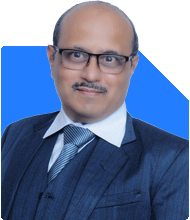54-Year-Old Investor With 3.75 Cr. Seeks Portfolio and Retirement Advice
Milind Vadjikar | Answer |Ask -Follow
Insurance, Stocks, MF, PF Expert - Answered on Oct 08, 2024
He has a mechanical engineering degree from Government Engineering College, Sambhajinagar, and an MBA in international business from the Symbiosis Institute of Business Management, Pune.
With over 16 years of experience in stock investments, and over six year experience in investment guidance and support, he believes that balanced asset allocation and goal-focused disciplined investing is the key to achieving investor goals.... more

Hi Sir, iam 54 years old investor, recently resigned and active in shares trading and investing last 20 years. liquid assets approx. 3.75 cr. Rental income 33k and Gold another 1cr. Immovable property home and vacant shop 2 cr each. wife 51 yr old-home maker. Medical Policy 20 Lacs. household expenses 1.75 lacs inclusive of 45k of SIPs as per table. SCHEMES UNITS SIP VALUE AXIS LONG TERM - D 8247 240000 ADITYA BIRLA SL TAX RELIEF 96 D 759 150000 AXIS BLUE CHIP G 5702 375000 MIRAE ASSET LARGE CAP G 1151 130000 HDFC BALANCE ADVANTAGE D 6905 5000 285000 HDFC MID-CAP OPPORTUNITIES D 5616 5000 335000 ICICI PRU LIFE BLUE CHIP FUND G 6652 5000 750000 PARAG PARIKH LONG TERM G 6087 5000 500000 KOTAK FLEXI CAP FUND GROWTH 1694 145000 SBI BLUE CHIP GROWTH FUND 5814 550000 AXIS MIDCAP FUND DIVIDEND 2165 100000 SBI SMALL CAP REGULAR GROWTH 895 5000 170000 KOTAK EMERGING EQUITY FUND 1306 5000 180000 SBI LARGE AND MIDCAP FUND 261 5000 155000 MOTILAL NIFTY DEFENCE INDEX G 5000 45000 NPS 12000 10000 1700000 45000 5810000 Goals / Requirements : *Need following funds next year - daughter marriage 30 lacs and son education 50 lacs and my retirement corpus plus 15 lacs for car. *mutual fund portfolio re-alignment. Queries : *should i sell commercial shop and invest in FDs / MFs / Shares. Rental value is 50k which is less as compared to invest 2 cr in FDs also will fetch me 1.25 lacs per month. will be able meet next year requirement also without selling my liquid portfolio. *also should i go for SWPs for all inactive MFs upto to the extent of 45k to fund my SIP and NPS from allocation and can also increase the SIPs, if suggested. * should i increase NPS allocation by another 5k for better retirement prospects or any other suggestion related to retirement as to how much more money needed to meet ends.
Query1:
Yes it is better to sell low rent yielding commercial property now, utilise the sell proceeds to fund you goals next year i.e. daughter's marriage, son's education and car purchase while the balance should be invested in mutual funds(equity savings type mutual fund)
Query 2:
Exit all inactive mutual funds and invest corpus(16.9 L) in Mirae Asset equity savings fund (low to moderate risk profile).
You should then start an SWP at 3.6% so as to generate income of 5 K for additional monthly allocation to NPS.
You should do SIP only in following 3 funds:
SBI hybrid equity fund(15 K)
HDFC balanced advantage fund (15 K)
ICICI Pru Multi asset allocation fund (15 K)
The taxation of these funds is like equity funds but they have exposure to alternate asset classes to impart some stability to corpus during extreme market fluctuations which is also suited for your age category.
Liquid assets+ gold+ NPS corpus will add up to approx 6.51 Cr which if annuitized will yield post tax monthly income of 2.15 L.
MF corpus may still grow to build up your inflation war chest.
Health care cover for family needs enhancement upto 50 L minimum as a safe precaution.
Reduce exposure to direct equity as you near retirement. You may continue trading as a hobby with a minimum risk capital with adequate knowhow, setup and temperament.
Happy Investing!!
You may follow us on X at @mars_invest for updates.
*Investments in mutual funds are subject to market risks. Please read all scheme related documents carefully before investing.
You may like to see similar questions and answers below
Ramalingam Kalirajan |10881 Answers |Ask -Follow
Mutual Funds, Financial Planning Expert - Answered on Apr 05, 2024
Ramalingam Kalirajan |10881 Answers |Ask -Follow
Mutual Funds, Financial Planning Expert - Answered on Jun 02, 2025
Nitin Narkhede | Answer |Ask -Follow
MF, PF Expert - Answered on Jul 02, 2025
Dr Dipankar Dutta |1841 Answers |Ask -Follow
Tech Careers and Skill Development Expert - Answered on Dec 14, 2025
Nayagam P P |10854 Answers |Ask -Follow
Career Counsellor - Answered on Dec 14, 2025
Radheshyam Zanwar |6744 Answers |Ask -Follow
MHT-CET, IIT-JEE, NEET-UG Expert - Answered on Dec 14, 2025
Radheshyam Zanwar |6744 Answers |Ask -Follow
MHT-CET, IIT-JEE, NEET-UG Expert - Answered on Dec 14, 2025
Dr Dipankar Dutta |1841 Answers |Ask -Follow
Tech Careers and Skill Development Expert - Answered on Dec 14, 2025
Dr Dipankar Dutta |1841 Answers |Ask -Follow
Tech Careers and Skill Development Expert - Answered on Dec 13, 2025
Dr Dipankar Dutta |1841 Answers |Ask -Follow
Tech Careers and Skill Development Expert - Answered on Dec 13, 2025
Mayank Chandel |2575 Answers |Ask -Follow
IIT-JEE, NEET-UG, SAT, CLAT, CA, CS Exam Expert - Answered on Dec 13, 2025
Radheshyam Zanwar |6744 Answers |Ask -Follow
MHT-CET, IIT-JEE, NEET-UG Expert - Answered on Dec 13, 2025
Mayank Chandel |2575 Answers |Ask -Follow
IIT-JEE, NEET-UG, SAT, CLAT, CA, CS Exam Expert - Answered on Dec 13, 2025
























